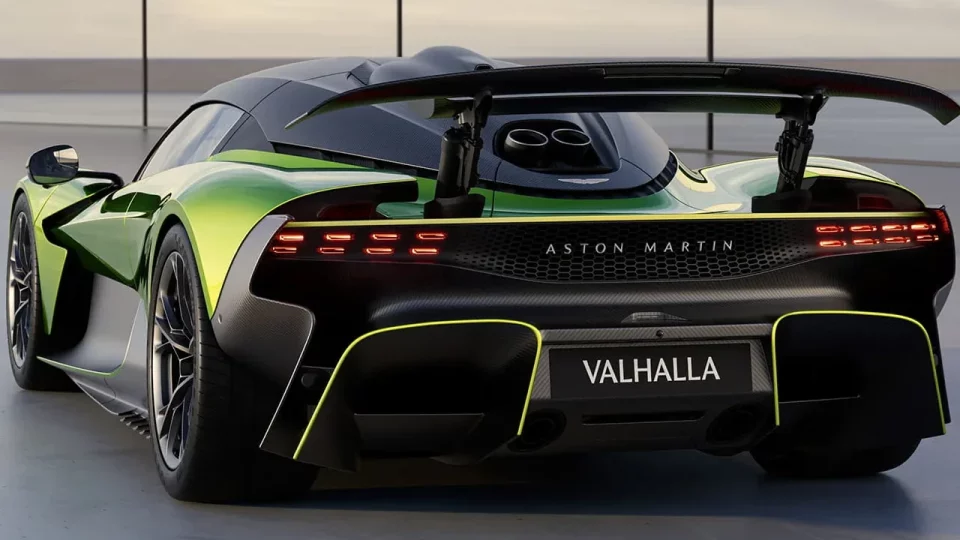Aston Martin has long stood as a beacon of innovation and luxury. Now, the marque is set to challenge the conventions of automotive engineering and design with the 2026 Aston Martin Valhalla, a groundbreaking mid-engine supercar boasting a 1064-horsepower plug-in hybrid powertrain.
Slated for delivery in late 2025, the Valhalla is a bold leap forward in both performance and technology, blending electrification with raw internal combustion power.
Table of Contents
The Valhalla’s Hybrid Heart
At the core of the Valhalla’s innovation is its plug-in hybrid powertrain, a harmonious marriage of cutting-edge engineering and performance-driven design.
A V-8 Engine Like No Other
The Valhalla’s combustion engine is a twin-turbocharged 4.0-liter V-8, inspired by Mercedes-AMG technology but extensively modified by Aston Martin. Featuring a flat-plane crankshaft for high-revving capabilities, this engine churns out an impressive 817 horsepower, an increase from earlier projections. To ensure peak performance under extreme conditions, Aston Martin equipped the V-8 with a dry-sump lubrication system, bespoke camshafts, and upgraded pistons. This attention to detail is critical for delivering the reliability and power demanded by both racetrack and road.
The Electrification Advantage
Adding to the internal combustion engine’s might are three electric motors. Two radial flux motors power the front axle, while a third motor, integrated into the eight-speed dual-clutch transmission, enhances the rear axle’s capabilities. This innovative arrangement allows the Valhalla to deliver seamless acceleration, precise torque distribution, and improved energy efficiency. The combined system produces an astonishing 1064 horsepower and 811 pound-feet of torque.
With a compact 6.0-kWh battery at its core, the Valhalla’s hybrid system is optimized for quick energy deployment and regenerative braking. The car offers a purely electric mode with a modest nine-mile range and an 80-mph top speed, making it not only a supercar but also a practical solution for urban environments.
Intelligent Transmission Design
Aston Martin’s engineers have introduced an eight-speed dual-clutch transmission specifically tailored for the hybrid powertrain. This gearbox eliminates a conventional reverse gear, relying instead on the electric motors for backward motion. This design not only reduces weight but also enhances efficiency. Additionally, the e-motor in the gearbox plays multiple roles: starting the engine, synchronizing gears, and providing torque boost during acceleration, thereby reducing turbo lag.
Unparalleled Driving Dynamics
Aston Martin has gone to extraordinary lengths to ensure that the Valhalla delivers a driving experience that matches its astronomical power output.
Carbon-Fiber Construction
The Valhalla’s lightweight carbon-fiber tub forms the backbone of its chassis. With aluminum subframes and an overall dry weight of 3649 pounds, the car strikes a delicate balance between structural rigidity and agility. This construction method not only enhances performance but also ensures safety and durability.
Formula 1-Inspired Suspension
Drawing inspiration from its Formula 1 ventures, Aston Martin equipped the Valhalla with advanced suspension systems. The front features a pushrod design with inboard-mounted springs and dampers, while the rear employs a multi-link setup. Bilstein-supplied adaptive dampers ensure optimal handling across various driving modes, from the aggressive Race mode to the efficiency-focused Pure EV mode.
Braking and Regeneration
Stopping power is provided by Brembo carbon-ceramic brakes, with massive discs measuring 16.1 inches up front and 15.4 inches at the rear. These brakes, combined with a sophisticated brake-by-wire system, offer exceptional stopping performance. The Valhalla also incorporates two forms of regenerative braking: one through the front motors during braking and another through the rear motor during deceleration.
Aerodynamics: Sculpted by the Wind
Supercars are as much about aerodynamics as they are about power, and the Valhalla sets a new benchmark in this regard.
Active Aero Features
The Valhalla’s active aerodynamics system is a masterclass in engineering. The car produces up to 1323 pounds of downforce at high speeds, thanks to elements like the rear wing, which deploys hydraulically in Race mode to optimize airflow and provide braking assistance. The front wing, meanwhile, adjusts dynamically to maintain balance with the rear, ensuring consistent handling across various driving conditions.
Underbody Airflow
Aston Martin has invested heavily in refining underbody aerodynamics. Venturi tunnels channel air through the chassis to a massive rear diffuser, generating significant downforce without adding drag. Concave surfaces and strategically placed vanes further manage airflow, directing it to coolers and enhancing stability.
Design and Craftsmanship: A Fusion of Elegance and Purpose
While the Valhalla’s performance credentials are staggering, its design is equally captivating, merging race car functionality with Aston Martin’s signature elegance.
Exterior Aesthetics
The Valhalla’s exterior is a visual masterpiece. Its low-slung, streamlined profile is accented by aggressive elements like a prominent front splitter and a reimagined rear diffuser. Buyers can opt for a painted carbon-fiber finish or leave the material exposed for a raw, industrial look. Dihedral doors not only add to the car’s dramatic flair but also improve ingress and egress.
A Focused Interior
Inside, the Valhalla offers a minimalist cabin with motorsport influences. Carbon fiber dominates the interior, featured in the dashboard, center console, and steering wheel. A flat-bottomed steering wheel, resembling an F1 yoke, adds to the racing ambiance. The digital gauge cluster adapts in Race mode, showing a linear tachometer and shift lights for optimal performance monitoring. A central touchscreen provides access to the car’s “Powerflow” graphic, which visualizes energy deployment and recuperation in real time.
What Lies Ahead for the Valhalla
With production limited to 999 units and a projected price tag near $1 million, the Valhalla is poised to be an exclusive offering in the automotive world. Initially planned for release in 2023, deliveries have been pushed to late 2025, reflecting Aston Martin’s meticulous approach to engineering and refinement.
